PRESTO PLANS
Sent straight to your inbox
CLICK HERE TO ACCESS
Sign up to receive 10 ready-to-use ELA resources your students will love!
10 FREE ELA RESOURCES
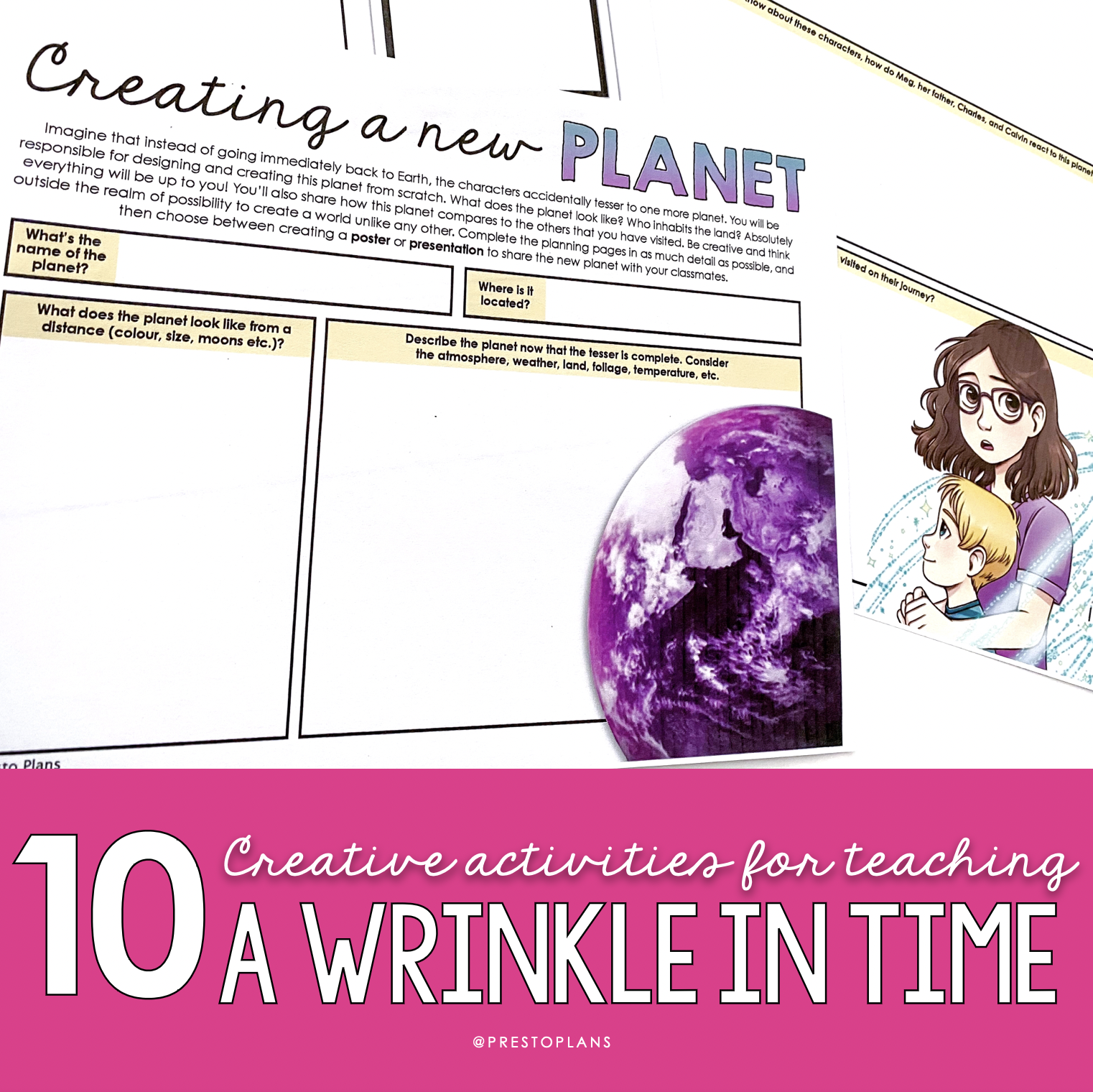
Teaching A Wrinkle in Time by Madeleine L’Engle – 10 Activities
I love choosing novels for middle school ELA that encourage students to explore themes they might relate to in their own lives. A Wrinkle in Time by Madeleine L’Engle, originally published in 1962, is one of those rare books that genuinely stands the test of time. I really enjoy teaching A Wrinkle in Time because it captures so many ideas and experiences that resonate with middle school students. This sci-fi classic is a celebration of individuality, bravery, and good triumphing against evil, and while it was first published more than 60 years ago, its timeless themes still resonate with students today.
As the main characters – Meg Murry, her brother Charles Wallace, and their friend Calvin O’Keefe – travel through space and time, readers are treated to beautiful prose, complex scientific ideas, epic battles – even a disembodied brain! If you’re considering teaching A Wrinkle in Time, here are some of my favorite activities to bring this classic sci-fi novel to life in the 21st century.
Chapters 1-2:
The quick Mind Reading activity can be a fun way to encourage students to empathize with Meg, who struggles to understand how her younger brother Charles has supernatural abilities. Charles always has the ability to know when Meg has had a particularly bad day at school, even before she has the chance to say anything!
For this activity, you’ll need to enlist the help of a student ahead of time – this person will be your “mind reader!” The idea is that you and this student will work together briefly before the lesson to make the rest of the class believe they can “read” your mind! To begin, you’ll want to select a student who you think can pull this off! Explain that you will place four objects at the front of the room (I like using a water bottle, an apple, a crayon, and an orange), send the “mind reader” out into the hallway, and then, with the rest of the class, choose one of the four items for the “mind reader” to identify! The class will be amazed that, over and over again, the “mind reader” gets the right answer!
What they don’t know (until you tell them!) is that you and the “mind reader” use a system of code words to secretly communicate about which object they should correctly “guess!” I like to follow this activity with a brief class reflection – a whole-class, paired, or small-group discussion – where students can connect this task to Meg’s experiences in the novel.
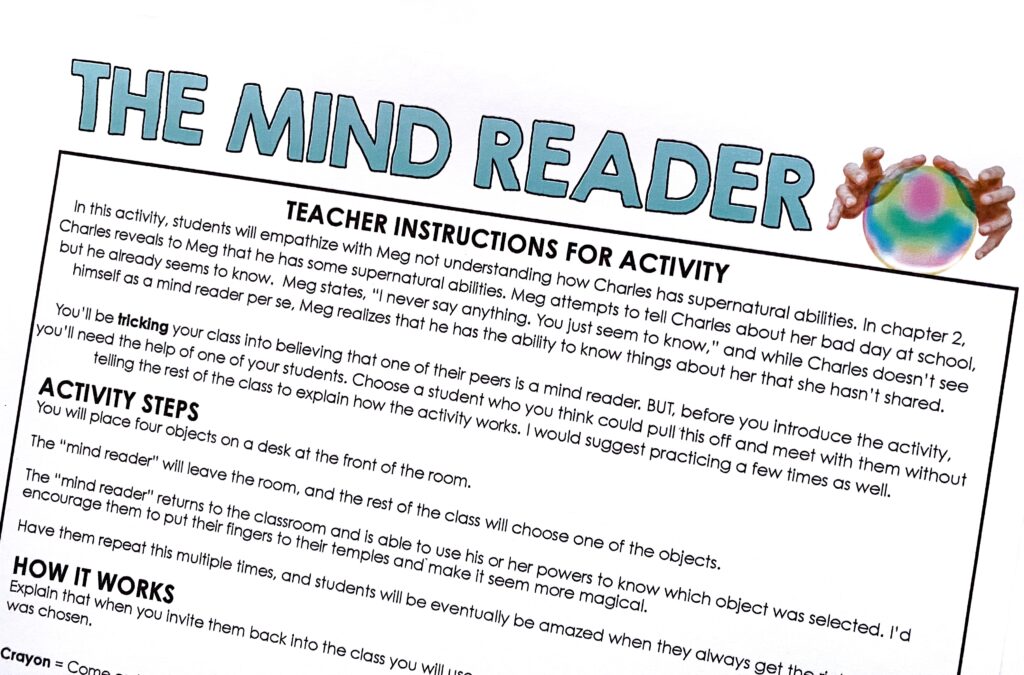
Chapters 3-4:
Teaching A Wrinkle in Time opens up new conversations about the ways in which schools (and teachers) can better meet the needs of students. In the third chapter of Madeleine L’Engle’s novel, Meg shares with Calvin that she is frustrated by having to solve math problems “their way.” She clearly shows that she understands the content, but she shows Calvin how to do it in a different way that makes more sense to her. Although Meg is clearly intelligent, she says, “If I get anything right nobody’ll believe it’s me.”
This scene often gets a strong reaction from students. With Meg’s experiences in mind, I like to introduce the Changing Education Paradigms activity. Here, encourage students to think critically about their own education and the system they are currently in.
HOW THE ACTIVITY WORKS:
- Guide the discussion by having students write as many responses as they can think of to the question: How many uses can you think of for a paper clip? (Tip: I like to set a timer – just for 30 seconds or a minute – to keep everyone on track.)
- Next, I show the class the RSA Animate video “Changing Education Paradigms,” which is based on a talk given by Sir Ken Robinson, a world-renowned expert in education.
- From here, I like to put students in groups. Then, I distribute task cards of quotes taken from the video to each group. Using the quote as a conversation starter, students can consider whether or not they agree with the point made. They also consider how it relates to their own schooling, and how it connects with Meg’s experience in A Wrinkle in Time.
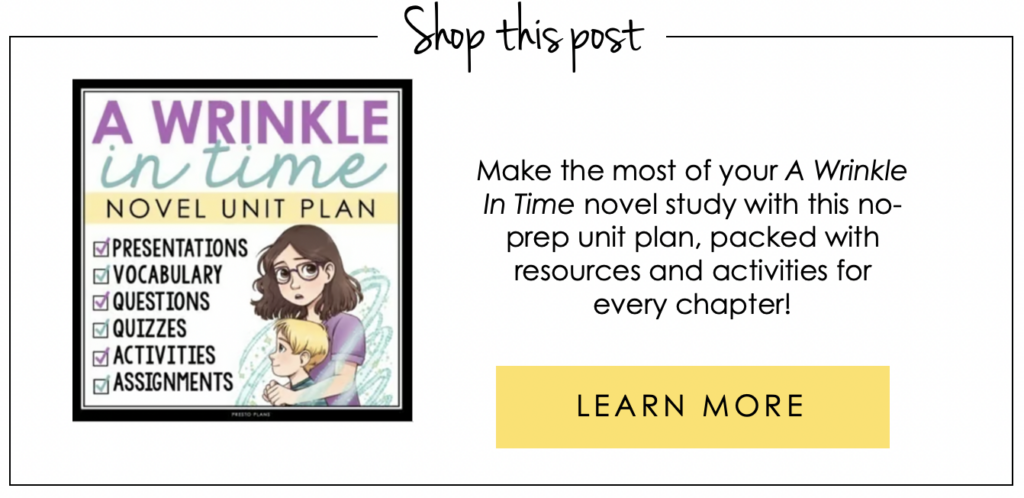
I love the versatility of this assignment – you can extend it in a variety of ways. You may choose to have students repeat the process by discussing two or three different prompts. Or, if you want to incorporate movement, you can have students move around the room to find prompts that resonate with them. To wrap up, you might also want to ask students to complete a brief written response, in which they propose improvements that could be made to their own education system.
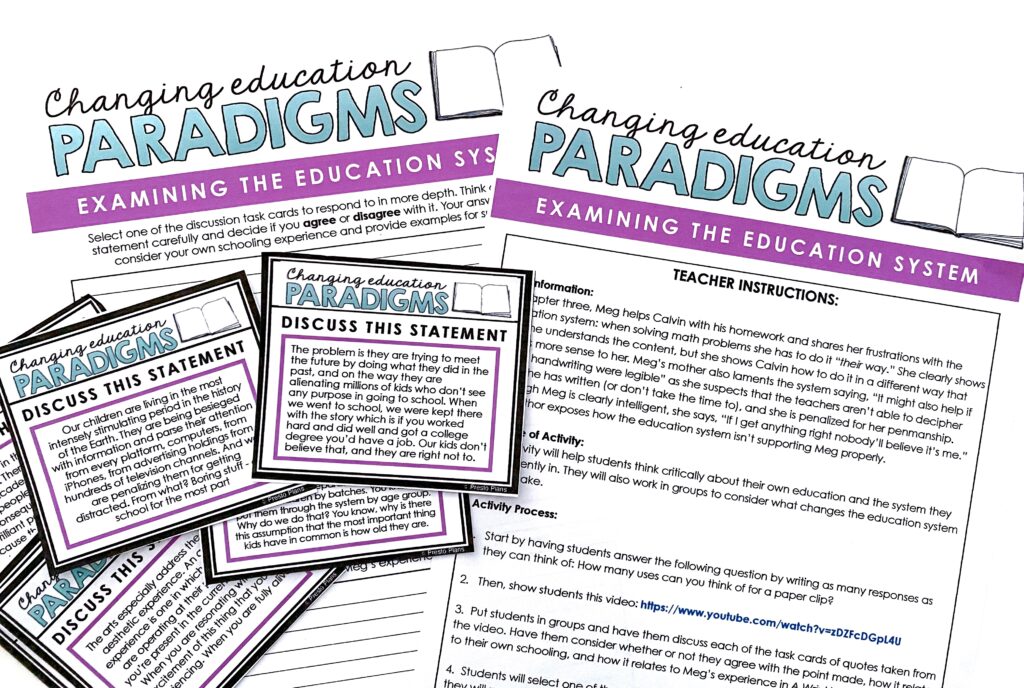
Chapters 5-6:
I really love incorporating creative activities when teaching A Wrinkle in Time. Chapters 5 and 6 are where the sheer enormity and importance of the children’s task – saving Meg and Charles Wallace’s father – is revealed. With this in mind, I like to spend a bit of time ensuring that students have a strong understanding of the events in these two chapters, as they lay the foundation for the action in the rest of the book!
BUILDING A TESSERACT
The concept of a “tesseract” – described as a cube in four-dimensional space in the novel – is how the Murry children and Calvin are able to travel through space and time. The tesseract is to the cube what the cube is to the square. While a cube consists of six square faces, the surface of the tesseract consists of eight cubical cells. In other words, it is a 4D shape where every face is a cube! This can be tricky for middle schoolers (and their teacher!) to understand and visualize.
To get a better understanding of tesseracts, I like to have students build their own models using provided templates. There are two different options to choose from – building tesseracts from paper templates, or out of pipe cleaners! Depending on your resources, you can use whichever option works better in your learning space. Alternatively, you could have groups of students build models in different mediums, and compare the results!
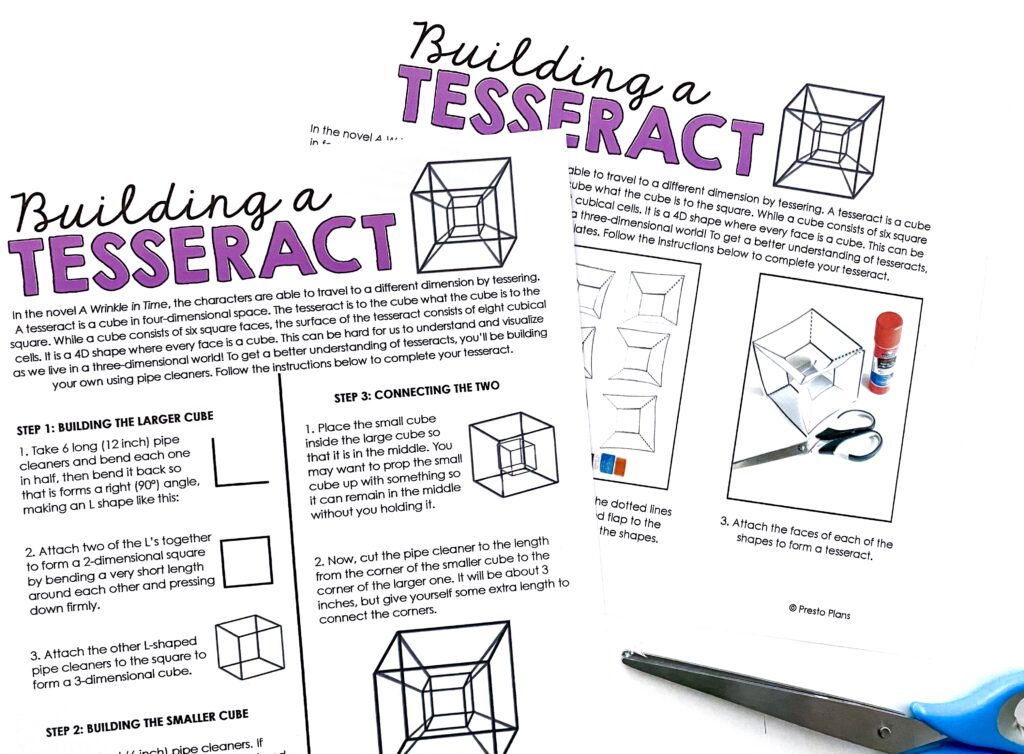
SOCIAL MEDIA ALLUSIONS
In Chapter 5 of A Wrinkle in Time, Mrs. Which explains to the children that they are “not alone” in their fight against evil. She refers to many fighters who have supported their cause throughout history, and Meg, Charles Wallace and Calvin offer their own suggestions of historical figures who have fought against evil forces in the past.
Teaching the concept of allusion – a passing reference to a person, event, or thing within a work of literature – can be tricky for middle schoolers. With this in mind, I like to re-read this section of A Wrinkle in Time. From here, I provide them with graphic organizers to support them in creating a social media profile of a changemaker from history! Some notable figures I like to encourage students to learn more about are William Shakespeare, Albert Einstein, and Leonardo Da Vinci, among others.
After students have had the opportunity to research and share their findings about their historical figure, I like to ask them to consider what the various historical figures have in common. Students often identify that many of the people who are commonly considered to be changemakers in history are typically white, and male, and have made significant contributions in science or the arts. With this in mind, I like to wrap up by having the class envision a diverse, 21st-century group of modern “fighters” who work to combat evil or injustice in the world.
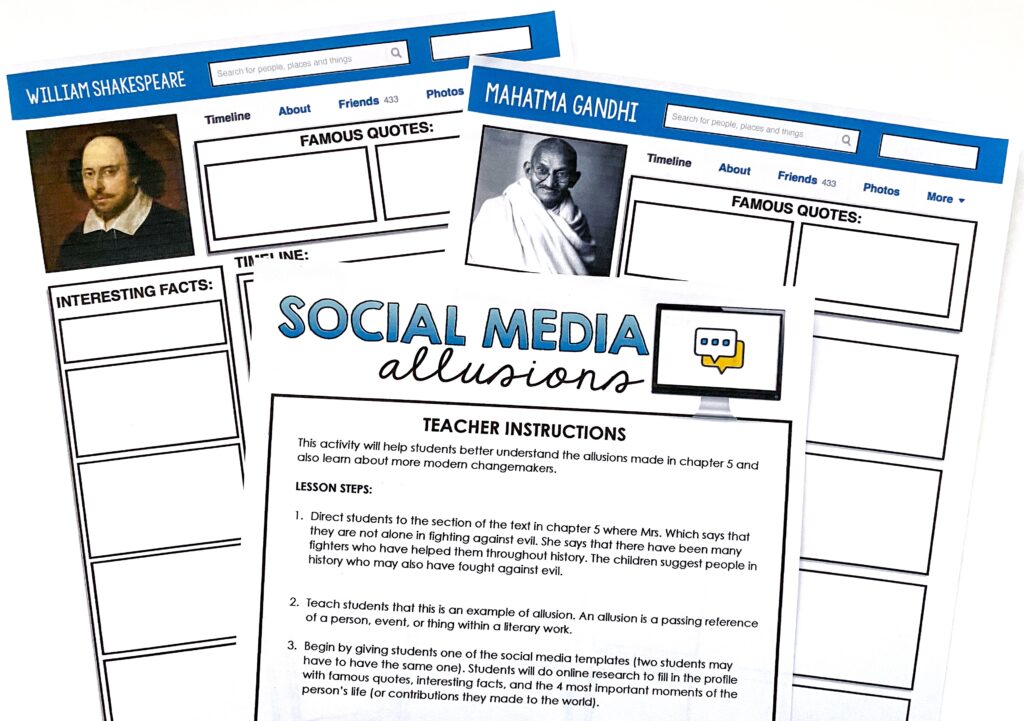
AWARENESS CAMPAIGN:
In Chapter 5, The Happy Medium does not want to look at Earth. She doesn’t want to look at unpleasant things when there are so many positive things to look at. Mrs. Which responds by saying, “There will no longer be so many pleasant things to look at if responsible people do not do something about the unpleasant ones.”
Considering this interaction, ask students: What is something unpleasant in the world or your country that you would like to change? Once they brainstorm their ideas, they can work alone or in groups to create an awareness campaign about their chosen topic. This assignment can be completed in a number of different ways. For example, students may choose to create a poster, brochure, presentation, or another product of their choice to bring awareness to the issue. Some groups may even wish to create awareness on a larger scale by hosting an assembly, or presenting to other classes!
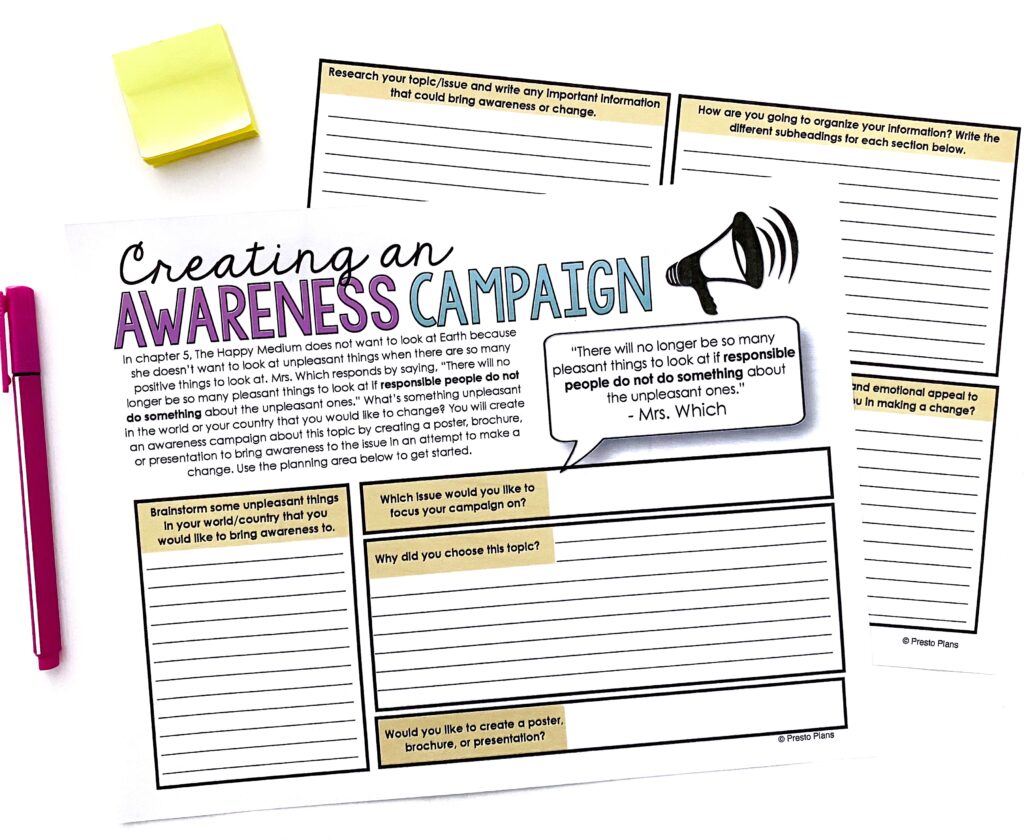
CAMAZOTZ MANUAL AND POSTCARD:
In Chapter 6, the Murry children and Calvin arrive on the eerie and dangerous planet of Camazotz. This, they learn, is where Mr. Murry is imprisoned. On Camazotz, individuality is strongly discouraged. As the children familiarize themselves with this strange new world, I like to invite middle school ELA students to imagine what a manual for life in Camazotz would look like. With the support of a graphic organizer, students write and design content for a page in the manual, creating a comprehensive guide to a place where uniformity is valued above all.
Another activity to help students gain a greater understanding of Chapter 6 is the Greetings from Camazotz postcard activity. In this task, students imagine they have won a vacation to Camazotz. Using a postcard template, they can write to a friend or family member back home about their experiences. I like this task because it reminds students to include relevant details from the novel to support their ideas.
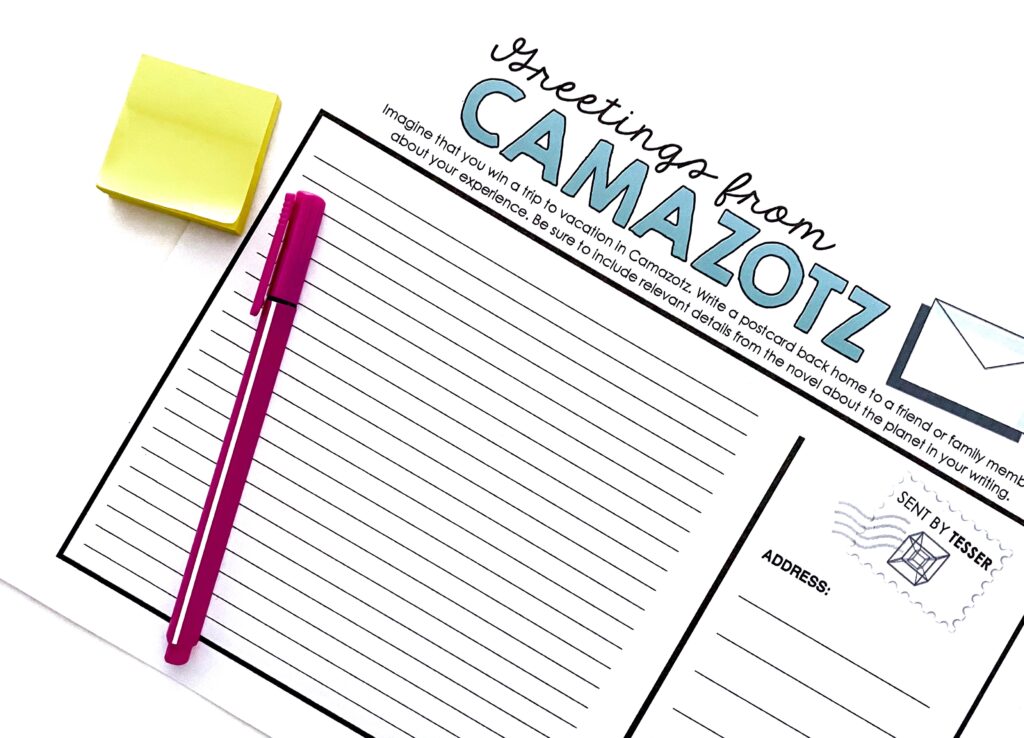
Chapters 7-8:
Chapters 7 and 8 of A Wrinkle in Time focus on the dangers of Camazotz and its emphasis on conformity. In a pivotal moment, Meg, Charles Wallace, and Calvin are tempted by a delicious-looking turkey dinner. Inspired by Madeleine L’Engle’s vivid descriptions of the food in this scene, I like to give middle school ELA students a chance to play with descriptive writing techniques.
In the Wrinkled Writing task, students work to collaboratively write a descriptive paragraph, focusing on different types of food! To begin, distribute the provided graphic organizer to students, with each person receiving a different food item. Next, I instruct students to describe the food using the sense of sight. When the time is up (I find five minutes works well), students “wrinkle” their paper by crumpling it into a ball. Next, they toss it to the front of the room (they love this part)! Then, they take a new ball of paper and describe their new food item using the senses of smell and touch. In the third round, students describe their new food item using the senses of taste and sound.
After the class completes three rounds of descriptive writing, the rough draft goes back to the first, original writer’s desk. From here, this person is responsible for doing all of the editing, changing, and revising to create a descriptive paragraph. They may add information they feel is missing or provide more detail. Once students make their final revisions and complete their good copies, they can share their writing with the whole class!
Chapters 9-10:
In Chapter 9, Charles Wallace discusses the “benefits” of equality on the planet Camazotz. As he says this, Meg realizes that the concepts of like and equal are very different. When teaching A Wrinkle in Time, this can be a great opportunity for students, like Meg, to realize that differences are essential! With this in mind, I like to foster a sense of classroom community by creating an Individuality Quilt.
This task, which incorporates visuals as well as writing, is a fantastic way to celebrate all the unique personalities in a middle school ELA class. Each student takes responsibility for creating an illustration that represents them in some way. This can be a self-portrait, images of activities they enjoy doing, favorite foods or things – the options are endless! Then, on a second (lined) square, students can respond in writing to a provided task card prompt. To display the quilt, I like to arrange the “squares” of the quilt on a large blank wall or bulletin board, alternating between images and writing.
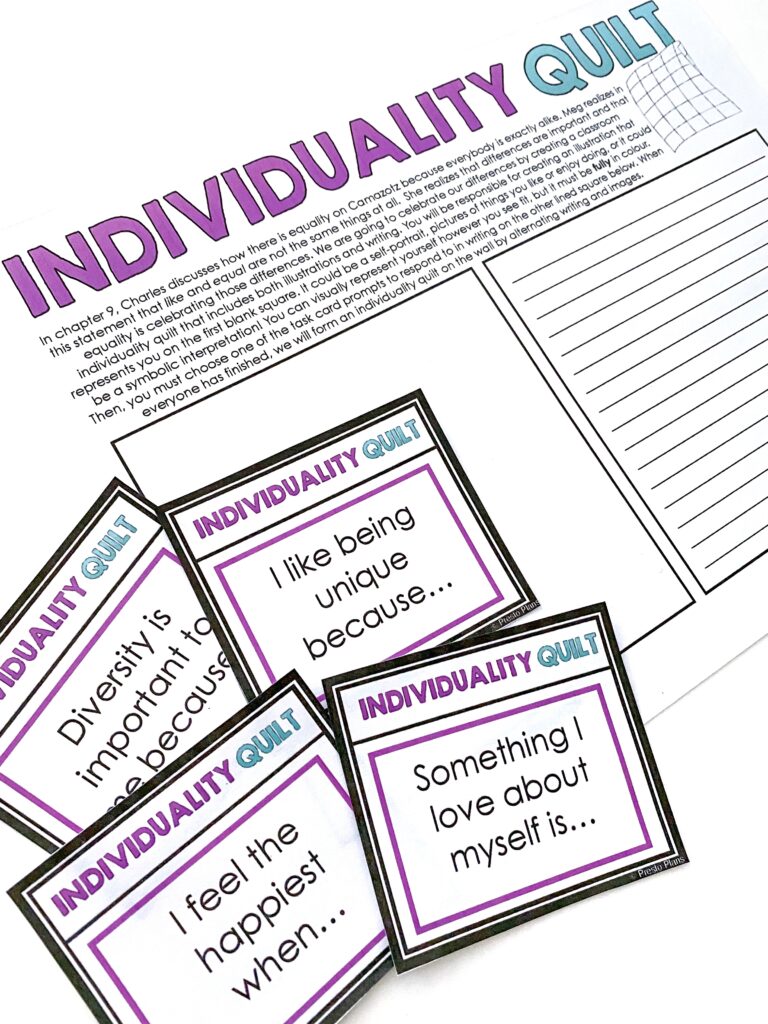
Chapters 11-12:
As you wrap up teaching A Wrinkle In Time, it can be fun to infuse a bit of creativity into your lessons! Here are two activities to try as you finish up your novel study:
WRITING A SONNET:
In Chapter 12, Mrs. Whatsit explains to the children that life is like a sonnet, and emphasizes the importance of individual freedom. This is an excellent opportunity to explore sonnets as a poetry form!
To begin, I like to share background information about sonnets. Using a comprehensive presentation for references, I explain the history of sonnets, as well as the strict organizational structure of this type of poetry. To help students understand more about iambic pentameter, I also include audio references to rhythm and rhyme schemes.
Once students have a solid understanding of the characteristics of a sonnet, it is time for them to try writing one of their own! Using a graphic organizer to remind them of the structure of a sonnet, students can draft their poems. To extend this creative activity, students can create an illustrated “good copy” of their sonnet to display in the school!
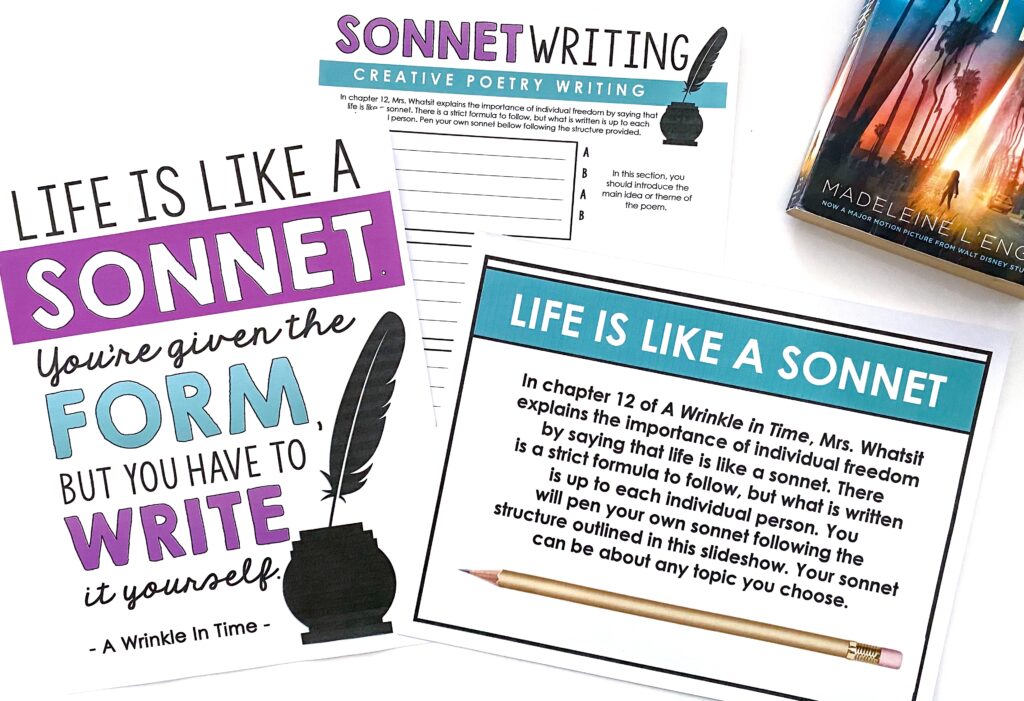
NEW PLANET CREATIVE PROJECT:
As a culminating activity for teaching A Wrinkle In Time, students may enjoy flexing their creative muscles one final time. Ask them to imagine an alternative ending to the novel – instead of going immediately back to Earth, the characters accidentally tesser to one more planet.
In this hypothetical scenario, students are responsible for designing and creating this planet from scratch. What does the planet look like? Who inhabits the land? Absolutely everything will be up to your class!
Students may complete this activity alone or in a small group. Using a graphic organizer to guide them through the planning process, students will share how this planet compares to the others in the novel. I really encourage students to think outside the realm of possibility to create a world unlike any other! Once the planning pages are complete, students can use the information to create a poster or presentation to share the new planet with their classmates.
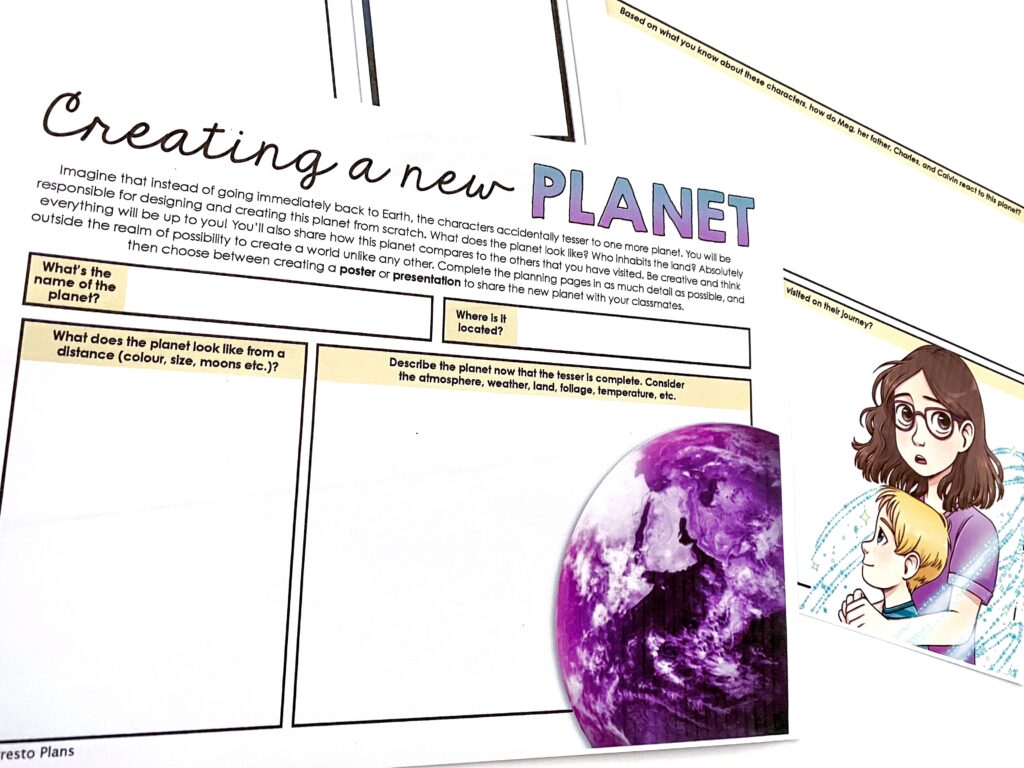
There you go! I hope these ideas give you a fresh perspective on teaching A Wrinkle in Time in middle school ELA. You can grab the ready-to-use novel unit plan below with all of the activities mentioned here, as well as everything you need to guide students through this fantastic novel.

Looking to explore more thought-provoking science fiction texts with your class? Check out my blog post on Teaching “A Sound of Thunder” by Ray Bradbury.
Search the blog for what you are teaching
GIVEAWAYS
sent straight to your inbox!
share this post